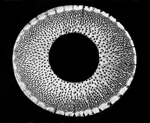|
1735: Kyōto Myōan-ji Temple Chief Administrator
Kandō Ichiyū's Letter about 'Sankyorei-fu',
the "Three Non-Dual Spirit Music Pieces"
虚霊山縁起並
ぴに
三虚霊譜瓣
KYOREI-ZAN ENGI NARABI ni SANKYOREI-FU BEN
"Origin of the Myōan-ji and Tradition of the Three Non-Dual Spirit Pieces
Date: Kyōhō 20, 9th month - October, 1735
Authored by Myōan-ji temple chief Kandō Ichiyū,
寛堂一宥, who (allegedly) died in 1738, Genbun 3.
Reprinted in Nakatsuka, 1979, pp. 133-135.
See a complete digitized online version of this important document on Iida Kyorei's Koshūan shakuhachi research website:
http://www.yo.rim.or.jp/~kosyuuan/kosyuan/iida/iida15.htm
This web page checked and updated on January 18, 2024.
Do note that, composed and issued by the Kyōto Myōan-ji, while this document does actually mention the name
'Fuke', 普化, 12 times,
you see no reference to any "Fuke Sect", Fuke-shū,
普化宗, at all.
This text is also the oldest known to present the later so very central term and concept of 'hōki',
法器,
"Buddhist Dharma instrument" - while, on the other hand, you do not see 'Honkyoku',
本曲,
"Original music"/"Basic music pieces" appearing anywhere in the text.
By the way, in the text the term 'Zen',
禅,
appears 6 times, and 'komusō',
虚無僧,
only twice.
Still, in the mind of the practitioner of ascetic shakuhachi "music", probably the most important piece of information presented in this unique Myōan-ji/Myōshin-ji document is that of describing the "three non-dual spirit music scores": 'san-kyorei-fu',
三虚霊譜 and their significance, first since Meiji times referred to as 'san koten shakuhachi honkyoku',
三古典尺八本曲,
namely: 'Mukaiji', 'Kokū', and 'Kyorei', that are here being mentioned, explained and discussed for the first time in a Kyōto Myōan-ji document.
THE TEXT - some preliminary translations of the text:
無生真 - MU-JŌ-SHIN
Among the many old Fuke Shakuhachi textual sources preserved at the Myōan-ji in Kyōto, one especially fascinating document is titled
Kyorei-zan engi narabi ni sankyorei-fu ben,
虚霊山縁起並ニ三虚霊譜辯,
"Towards an Understanding of the Origin of the Empty Spirit Mountain [i.e. the Kyōto Myōan-ji] and a Discourse about the Three Empty Spirit Music Pieces [i.e. Mukaiji, Kyorei & Kokū]".
Dated 1735 (Kyōhō 20, 9th month) this hand-scroll bears the signature of Kandō Ichiyū, 寛堂一宥,
18th chief monk in the traditional Myōan-ji lineage, who died in 1738, Genbun 3, 2nd month, 23rd day (Nakatsuka Chikuzen, 1979, pp. 133 & 150).
- - -
Par. 2:
興国開山法灯国師入宋帰国之日、
宋地、国作、宋恕、理正、法普
之四居士随待来干我邦、
皆是風顛漢、而以普化為祖、以尺八為法器、
幽柄鷲峰 谷、尋常弄尺八為遊戯三味、
共旧跡干今号普化谷。
"The founder of the Kōkoku (Temple), Hottō Kokushi, travelled to Sung (China), and on the day of his return (to Japan),
four Buddhist laymen of Chinese descent, Kokusaku, Sōjo, Risei and Hōfu, accompanied him to our country.
They were all highly cultured Chinese and with Fuke as their role model [lit. ancestor] and the shakuhachi as implement of the Buddhist Law [hōki],
confining [or, secluding] themselves in the valley beneath the Eagle Peak [the mountain where Kōkoku-ji is located],
they used to take pleasure in playing the shakuhachi as a way of practicing meditation [sammai].
Today, the site of their old common dwelling place [kyūseki] is called 'The Valley of Fuke'."
Par. 4:
虚竹有投機偈伝、
一従載断両頭後、
尺八寸中通古今、
吹起無生真一曲、
三千里外絶知音、
"Kyochiku had [or, favoured] a speculative Buddhist verse
which says,
'When one has cut off Dualism,
the essence of the shakuhassun
transcends Past and Present.
That one sound blowing forth
of the True Reality of the Non-born
exceeds the deepest of friendships,
beyond limit.'"
Par. 5:
嘗虚竹在城州宇治、号朗菴主、
命終樹塔於宇治郡五筒庄中、
人呼為普化塚也。
"Once Kyochiku stayed in Uji in Jōshū [mod. Kyōto Prefecture] he called himself 'Rōan the Hermit'.
By the end of his life he erected a five-levelled monument
[a 'gorintō' grave pagoda?] in the vicinity of Uji.
People call it 'The Grave of Fuke'."
Par. 6:
至於第二世明普、居干洛東、
建立虚霊山明暗寺、
於今普化一流相承来也、
"As for Kyochiku's successor Myōfu, when he lived in the East of the capital [Kyōto Higashiyama],
he established [lit.: build] the Empty Spirit Mountain Myōan Temple,
and so the School [Jap.: ichi-ryū] of Fuke has been preserved till today."
- - -
The full text is reprinted in Nakatsuka, 1979, pp. 133-135.
Digitized by Iida Kyōrei c/o
Koshūan website
Trsl. by Torsten Olafsson, 2010, 2013.
五輪塔 - GORINTŌ



Gorintō - The Shingon Buddhist five element pagoda
- is a very common type of grave monument in Japan.
The five "rings" represent the Five Buddhist Elements of the Universe:
Earth, Water, Fire, Wind and Space.
The gorintō is believed to possess strong magical powers.
|
|



